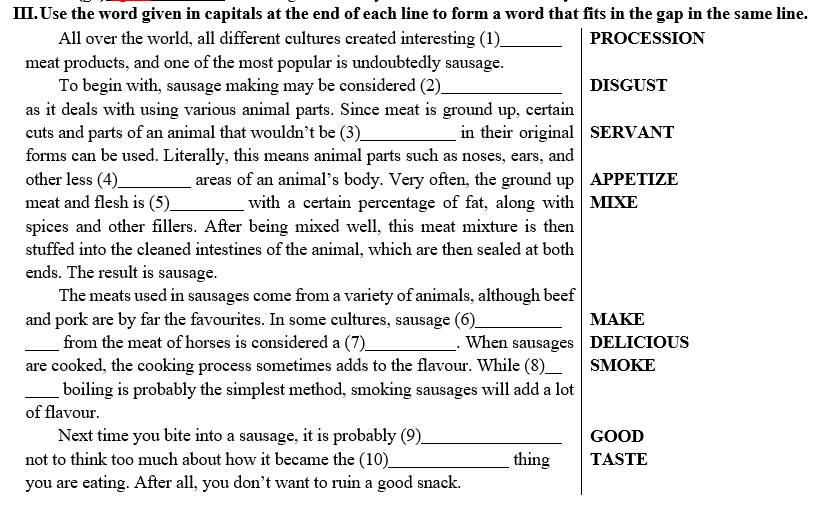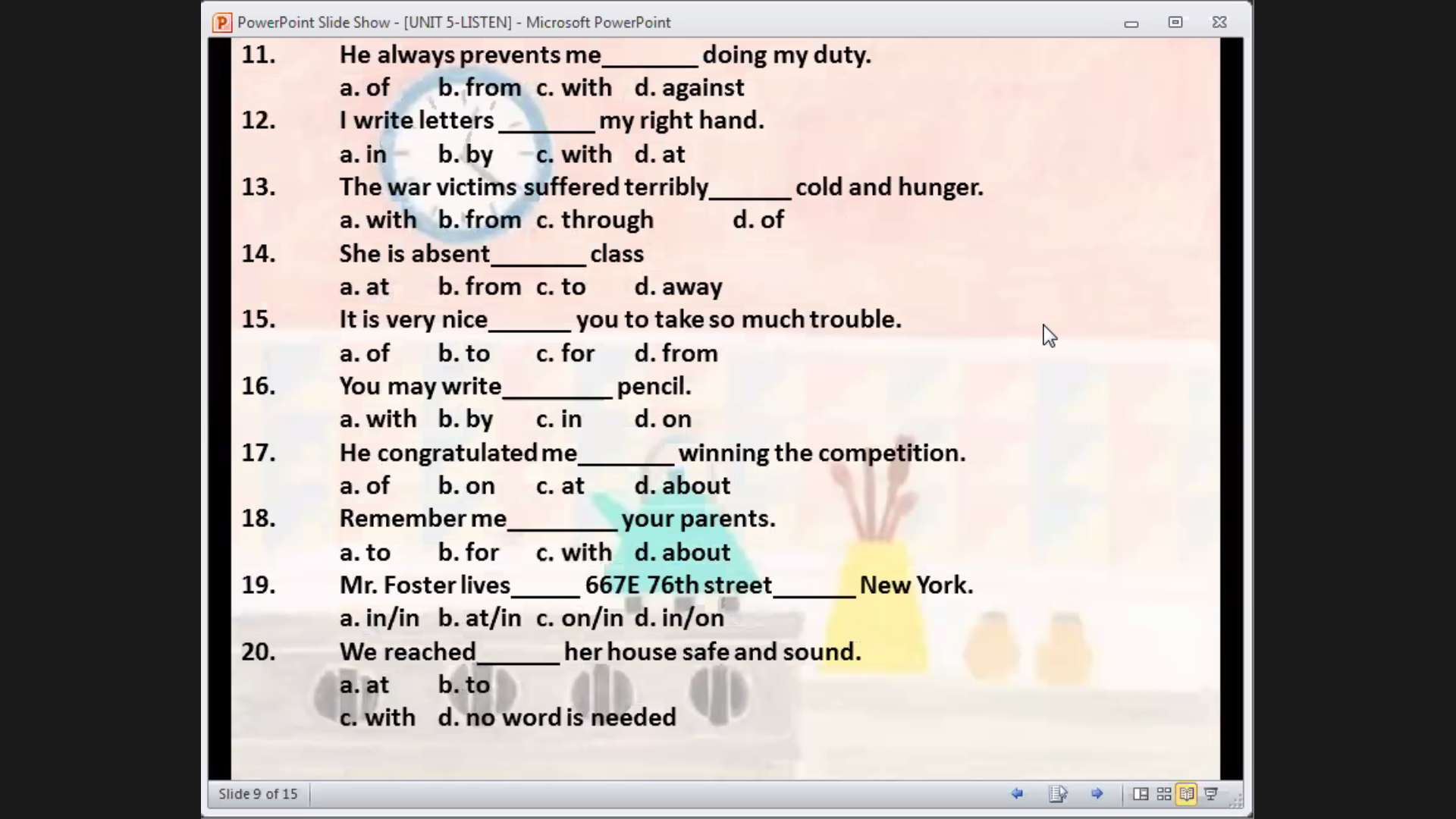1 processing
2 disgusting
3 served
4 appetizing
5 mixed
6 made
7
8 smoking
9 better
10 tasty
1 processing
2 disgusting
3 served
4 appetizing
5 mixed
6 made
7
8 smoking
9 better
10 tasty
GIẢI THÍCH ĐÁP ÁN DÙM MÌNH LUÔN VỚI Ạ

Read the passage and fill in the blanks with suitable words. GIẢI THÍCH ĐÁP ÁN DÙM MÌNH LUÔN NHÉ
Being the first and also the oldest high school in Hue, originally Quoc Hoc (National High School) was the school for children from royal and noble families. French colonialists opened this school in 1896 to train those (1) would serve the government. Therefore, at that time, French was the main subject for students. Now it is (2) Hue National High School and is a high-profile school that all students must pass a competitive (3) exam to get the admission.
Established in 1896, after more than 100-year history, the school today isconsidered the largest and also the most beautiful high school (4) in Viet Nam. This surrounding makes a great picture of red French designed buildings in Harmony with green (5) of a large shady trees and stone benches.
(6) in spring, when “diep anh dao” (a kind of cherry blossoms)is in bloom, the whole picture is filled with pinky dots above red thatched tile. Students often call that (7) of time “Pinky cloud season” and regard it as the most special moments of a year. These are the reasons why Quoc Hoc is also (8) “Pinky school beside Perfume River Bank” in the song with the same name.
Moreover, several Vietnamese (9) leaders have been learning here, including: Nguyen Tat Thanh (President Ho Chi Minh), General Vo Nguyen Giap, Prime Minister Pham Van Dong, etc. In addition, the school is famed for its students who are well-known poets (Xuan Dieu, Huy Can, To Huu, Luu Trong Le etc.), scientists (Ta Quang Buu, Ton That Tung, Dang Van Ngu, etc.), musicians (Tran Hoan, Nguyen Van Thuong, etc.). The school also has students getting high prizes in many international (10) .
Choose the underlined word or phase (A,B,C or D) that needs correcting.
1. Hanh can't go to the movies with us tonight because she had to do her homework.
A. can't
B. with
C. because
D. had
GIẢI THÍCH DÙM MÌNH TẠI SAO LẠI CHỌN ĐÁP ÁN ĐÓ LUÔN Ạ, THANKS:<3
Thầy/ cô giải thích giúp em với ạ! Em có để cả đáp án r đó ạ nhưng em không hiểu tại sao lại chọn đáp án đó 

Chọn đáp án và giải thích ạ(chỉ cần giải thích ngắn thôi ạ)



giải thích dùm em luôn ạ. e cam rơn
III. Fill in the blank with a suitable word. GIẢI THÍCH ĐÁP ÁN LUÔN VỚI Ạ
Isn’t it amazing how much time we spend (1) about food? “Have you ever eaten ...?” “What did you have for lunch?” and so on. And when you travel from one country to another, you find that people have quite different (2) about food. People often feel that what they eat is normal, and that what other people eat is strange or silly.
In most parts of Asia, for example, no (3) is complete without rice. In England, people (4) potatoes every day. In the Middle East, bread is the main part of every meal. Eating, like so many things we do, becomes a (5) which is difficult to change. Americans like to drink a lot of orange juice and coffee. The English (6) tea four or five times every day. Australians drink large amount of beer and the French drink (7) every day.
The sort of meat people like to eat also differs from one country to another. Horse (8) is thought to be delicious in France. In Hong Kong, some people enjoy eating snakes. New Zealanders eat sheep, but they never eat goat meat. The Japanese don’t like to eat sheep meat because of its smell, but they enjoy raw fish.
So it (9) that although eating is a topic that we can talk about for hours, there is very little (10) sense in what we say about it. People everywhere enjoy eating what they have always been earing, and there is very little we can do to change our eating habits.
GIẢI THÍCH ĐÁP ÁN GIÚP MÌNH VỚI Ạ, MÌNH CẢM ƠN NHIỀU
Today, in many parts of the world, it is customary for people to shake hands upon meeting as gesture of good will. Originally, however, the practice of shaking hands had more practical purposes.
Shaking hands originated in medieval times. In those days, when a man came on a stranger, he would often automatically reach for his sword with his right hand, in case he had to use the weapon to defend himself. Sometimes, both parties found themselves circling around each other, weapons in hand, until it was mutually agreed that the weapons could be laid aside. Then the two parties extended their right hands to show they had no weapons, and clasped them. This was the beginning of the handshake.
The custom of shaking hands is not a universal one. In the orient, people have for centuries, clasped their own in front of them upon meeting to show that they held no weapons. In France, a custom developed in which people who met would kiss each other on both cheeks. The natives of some South Seas islands greet by rubbing noses. Note: clasp (v): nắm chặt, siết chặt.
28. At first the purpose of shaking hands was _________.
A. to show a good relationship with each other B. to show that there were no weapons in hands
C. to show that both parties were ready for fight D. a gesture of good will
29. To show that one has no intention to fight _________.
A. shaking hands has been practised all over the world B. the oriental people kiss each other’s hand.
C. people laid aside their weapons D. there have been various ways depending on different cultures
30. According to the passage, the practice of shaking hands _________.
A. was used to extend greetings B. used to be popular, but now it is out of date
C. is replaced by other customs in some countries D. is considered not to be polite
31. The word “came on” in the second paragraph can be best replaced by _________.
A. waited for B. visited C. attacked D. happened to meet
32. Which of the following is not true about the handshake?
A. It happened for the first time very long time ago. B. It is a gesture of good will.
C. It Is very popular all over the world D. It Is one of the social customs.
I watched the play until the end of the first act, _______ I found I had seen enough.
A. on which point
B. at that point
C. from which point
D. at which point
giải thích đầy đủ,lí do chọn đáp án đó ạ,có cấu trúc thì cho mình xin luôn ạ